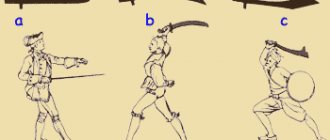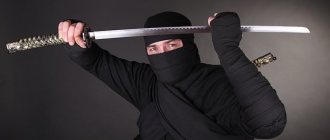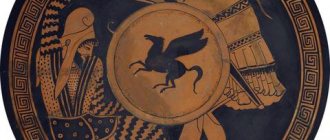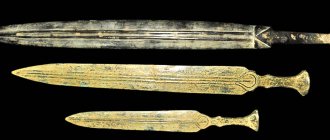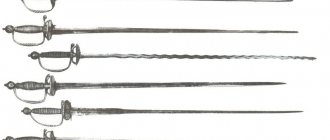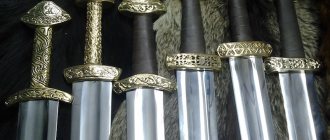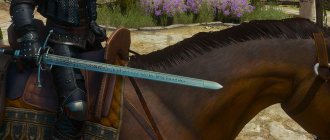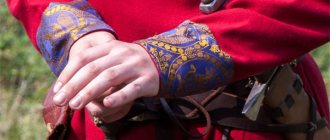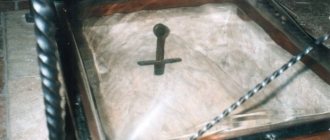Then the symbolic meaning took hold. And even preferring an ax or a heavy spear in battle, for a holiday or a solemn ceremony, those who could afford it attached a scabbard with a sword to their belt. Then the times of chivalry came, and the sword acquired the meaning of a sacred object, the touch of which on the shoulder made a knight out of an ordinary person. It is not surprising that warriors treated their swords in a special way. They were given names and treated as comrades in arms. And the swords that belonged to the kings were also endowed with symbols of power. The significance of some swords was so great that they went down in history along with heroes of flesh and blood. We present to readers the ten most famous blades of the West and East.
Joyeuse
The name of this sword means "Joyful". It is believed that it belonged to Charlemagne, one of the largest military and political figures of the Middle Ages. In the 8th and 9th centuries, Charles waged continuous wars, uniting European lands, and in 800 he declared himself Emperor of the West. The Joyeuse sword is described in the famous poem “The Song of Roland”. There, miraculous properties are attributed to it - supposedly the blade can change color, and a fragment of the spear of Longinus is inserted into its hilt. The same one with which the Roman centurion Longinus pierced the crucified Christ. It is not surprising that the emperor valued Zhu-ayoz extremely. They say that one day the sword was lost on the battlefield. One of the knights found him and returned him to the emperor. In gratitude, he became lord of the surrounding lands and received a new surname - Joyeuse. The nearby city was also named. The town still stands in southeastern France near Lyon. And the noble family of Viscounts (later Dukes) de Joyeuse played a significant role in the history of the country. Since the 13th century, Joyeuse became one of the state regalia of France and was used during the coronation of new monarchs. These days, the famous sword is on display in the Louvre. However, research has shown that its pommel was made in the 10th-11th centuries, the decorations on the crosshair - around the 12th, and the hilt itself - in the 13th or 14th centuries. And only the blade can claim to date back to the reign of Charlemagne. However, many doubt this too.
Shcherbets
One of the most revered national relics of Poland is the Szczerbiec sword. It belonged to the Piast dynasty. As the legend tells, in 1018, the Polish prince Boleslav I the Brave (one of the first representatives of this dynasty, whose historical existence is confirmed) moved with an army to help his son-in-law - the Russian prince Svyatopolk the Accursed. On the banks of the Bug River, he defeated the troops of Yaroslav Vladimirovich (in the future nicknamed the Wise), and then took Kyiv. Allegedly, upon entering the city, Boleslav swung his sword and struck the Golden Gate with force. As a result, a noticeable notch (chap) formed on the sword, and from then on it got its name. But the Golden Gate was built later than Boleslav’s campaign - the first mention of them dates back to 1034, when Yaroslav the Wise was already sitting in Kyiv. Therefore, sometimes almost the same legend is told about the great-grandson of Boleslav the Brave - Boleslav II the Brave. But this also does not correspond to historical reality, because under Boleslav II the Poles did not enter Kyiv. The real history of the sword can be traced back to the 13th century. Beginning in the 14th century, it began to be used at the coronations of Polish monarchs. After the partitions of Poland at the end of the 18th century, Szczerbiec ended up in Prussia. And in 1883 it was transported to Russia, where it was exhibited in the Hermitage, which was already open to the public. In 1928, the Soviet government returned the relic to Poland. Today Szczerbiec is located in the old Polish capital - Krakow.
Interesting Facts
Usually everyone chose a handle decorated with decorative elements, but no one chose an ugly and untreated one. However, at the end of the 19th century, the wearing of swords, all except wooden ones, was prohibited in Japan. And the untreated hilt began to gain popularity, since the blade was not visible in the scabbard, and the sword could be mistaken for a bokken. In Russia, a katana is characterized as a two-handed saber with a blade over 60 cm.
However, not only the katana was used by samurai. There are lesser known and popular types of Japanese swords. They are described below.
Tisona
Rodrigo Diaz de Bivar, aka El Cid, or simply Campeador (The Winner) is the most revered Spanish knight. He lived in the 12th century during the Reconquista, the merciless battles between Christians and Moors. And he accomplished many feats - both personally and at the head of the army. It is believed that he never lost a battle. Moreover, he won the latter after his death - the armored body of the knight who died from his wounds was placed in the saddle so that the warriors would think that their leader was alive and would go into battle without fear. El Cid took his sword Tisonu as a trophy from the Moorish king Bukar, whom he killed in battle. In the 12th century, this blade was valued at a thousand marks - a huge amount for those times. The Spanish epic “The Song of My Cid” describes how enemies surrendered to Campeador’s mercy as soon as they saw Tizona in his hand; it was believed that the owner of this blade could not be defeated. After the death of El Cid, the sword passed to the Spanish kings. In the 16th century, King Ferdinand II of Aragon invited the Marquis de Falces to choose any reward in gratitude for his faithful service. The Marquis chose not lands, not castles or jewelry, but Tisona. As a family heirloom of the Falses family, it has survived to this day. Today, the legendary sword is displayed in the Cathedral of Burgos next to the tomb of El Cid. The sword, 103 centimeters long and weighing 1.1 kilograms, is a very valuable example of Spanish weapons from the 11th century. Only four similar blades have survived to this day.
General's curved saber of San Martin
The famous Argentine general Jose de San Martin fought for the liberation of South America. He was hailed as a hero and the First Defender of Peru. Thanks to his actions, Peru gained independence on July 28, 1821. To this day, the order of the same name is considered the highest award in Peru.
One day, an experienced commander acquired a curved sword in London. San Martin immediately noted the item's suitability for combat. Following his example, he armed his army with curved swords. This greatly affected the effectiveness of combat.
Curved saber of the Argentine General San Martin
The crooked blade served San Martin until his death, and then it passed to the General of the Republic of Argentina, Don Juan Manuel de Rosas. In 1896, the saber was transferred to the Buenos Aires Museum, where they tried to steal it twice, but fortunately without success.
Dovmont's sword
In Pskov there is kept a sword that belonged to Prince Dovmont - baptized Timothy, who ruled the city in the 13th century. Dovmont was an outstanding military leader, and it was thanks to him that the city was able to withstand the onslaught of the knights of the Order of the Sword, who repeatedly approached its walls. Thanks to the activities of Dovmont, Pskov rose and got rid of dependence on Novgorod. The prince's sword has clearly traveled a long and difficult path. On its blade is the mark of gunsmiths from the city of Passau on the territory of modern Austria - the famous “Passau top”. Swords with such a mark of hollows filled with yellow metal were worth their weight in gold in the 13th century. At the same time, scientists discovered that the hilt of the sword is not “native”. Apparently, the sword was broken in one of the battles, and then the blade, which became a little shorter, was transplanted to a new hilt. It is possible that the sword was broken in 1269. Then another order army approached the walls of Pskov. The Pskovians managed to fight back. Dovmont personally commanded the soldiers during the raid and, as one of the chroniclers writes, wounded the master of the order in the face with a sword. Dovmont was revered by the people of Pskov, and his sword became a symbol of the inaccessibility of the city and the fact that it was not afraid of any enemy. The image of a prince with a sword in his hand was minted on Pskov coins. The fact that the image is very similar to the blade kept today in the Pskov museum allows us to say that this is really the same sword that the legendary Dovmont fought with.
Katana
And finally, perhaps the most popular of the best Japanese swords. Katana in modern language means absolutely any representative of this type of weapon. As mentioned above, it was used by samurai as a long sword, most often it is paired with a wakaji. Weapons are always carried in a sheath to avoid accidental injury to others and yourself. Interestingly, the angle at which the katana is usually placed on the belt allows its true length to be hidden from others. A cunning and simple method appeared back in the Sengoku period. In those days, weapons were no longer a necessity; they were used more for the sake of tradition.
Nanatsusaya-no-tachi
This amazingly shaped blade is kept in the Japanese Shinto shrine Isonokami-jingu. It is mentioned in the ancient Japanese chronicle Nihon Seki in its story about the reign of the semi-mythical Empress Jingu, who occupied the throne in 201-269. Among other things, she was noted for having undertaken a successful campaign against Korea. As the chronicle says, just before the start of this campaign, the courtiers presented the empress with a sword with six branches from the blade. Due to its unusual shape, it was called Nanatsusaya-no-tachi, which means “Seven-Toothed Sword.” In 1870, it was possible to read the inscriptions made in gold on both edges of the blade. On one side was written: “Never before has there been a blade like this. The prince of the kingdom of Baekje, who lives by the sounds of August, made this sword for King Wa with the hope that it would last for many generations.” Baekje is one of the Korean states with which, according to the chronicles, Empress Jingu had diplomatic relations. The second inscription read: “On the 1st moon of the 11th month of the 4th year of the Taiva era, a sword was forged from steel 100 times stronger than normal. Use the sword to kill 100 enemies. For a worthy ruler." This made it possible to accurately date the creation of the “Seven-Tooth Blade.” The 4th year of the Chinese era Taiwa corresponds to the year 369. So it was still forged later than the reign of Jingu. King Wa, for whom it was intended, is the ruler of one of the kingdoms of Ancient China. Later, he somehow found his way to Japan, and the chroniclers made his story more ancient.
How to get
As mentioned above, getting the Black Sword Impact in Genshin is possible only in one way, and this way is donation.
To be specific, this is purchasing a Battle Pass
(be it “Pearl Hymn” or “Pearl Choir”) the rotation we need and reaching level 30 in it.
The black sword can only be obtained through a paid BP
Once you complete many tasks and reach the required level in the Battle Pass
, you can pick up a special chest, which will immediately open and offer a choice of one of five weapons, one for each type.
At level 30, a golden chest with weapons will be available
Our pick is, of course, the Black Sword, although you might want to consider other options:
Two-handed "Dragon Bone Sword" Spear "Mortal Combat" Bow "Green Onion" Catalyst "Solar Pearl"
Zulfiqar
The history of the sword, which first belonged to the Prophet Muhammad, and then to the fourth righteous caliph Ali, is very confusing. Today, anyone can see the sword, called Zulfikar, in the Topkapi Palace in Istanbul. The problem is that it is completely different from the numerous descriptions of this blade. The legendary Zulfikar was credited with many magical properties. For example, outside of combat it could be thrown up and left hanging in the air. Or the fact that Ali received it from the Archangel Gabriel (Jibrail) himself. In the Middle Ages, all these legends were believed, and the cry “There is no hero except Ali, there is no sword except Zulfiqar!” actively used by warriors of Islam. From the legends came the belief that Zulfikar’s blade was forked. In imitation of this, medieval eastern gunsmiths mastered the production of swords with two blades, which were called zulfikars. However, the sword exhibited in Istanbul has a regular blade, only decorated with wavy lines. Whether it belonged to the Prophet Muhammad is not known for certain (many Muslims believe that the real magical Zulfiqar is hidden in a secret place), but it definitely dates back to the 7th century and took part in the great battles of the era of the formation of the Arab Caliphate. Then, until the beginning of the 20th century, this particular blade was used in the ceremony of “taqlidi safe” (girdling with a sword) of the sultans of the Ottoman Empire. This is an analogue of a European coronation. Now Zulfiqar is revered as one of the shrines of Islam.
Elevation
The black sword can to some extent be considered a special weapon due to the way it is obtained, but to unlock its full potential you need to do the same as for other weapons: collect rare materials, accumulate mora and pour mountains of ore into your favorite blade enhancements are a typical process for ascending and overcoming the leveling barriers that arise when weapons reach certain levels.
To ascend the Black Sword you will need the following materials:
Arctic wolf teeth of varying quality, which can be obtained in the Cecilia's Garden dungeon only a few days a week - Tuesday, Friday and Sunday. If a better quality tooth is missing, then use an alchemy table. Various quality Branch of the artery of the earth that drops from Abyssal Mages. You can reforge simpler versions into better ones at the alchemy workbench. Slime mucus of different quality, as the name implies, is knocked out from slimes. The alchemy table will help you get better options. Mora, a lot of mora.
Table of changes in the basic parameters of the Black Sword during Ascension phases:
In total, to fully upgrade the Black Sword, you will need the following amount of materials:
Also, immediately after the 2nd phase of ascension, the Black Sword will change its appearance, turning on the Christmas lighting of the bloody parts and turning on the wings on the hilt:
Initial view After 2nd elevation phase
Sword of Mercy
The coronation ceremony of English monarchs uses five swords, which are carried before the new king or queen upon entering Westminster Abbey. However, all these swords are remakes. The original relics were destroyed in the 17th century during the dictatorship of Oliver Cromwell, who fought against “remnants of the past.” All but one. The Broken Sword of Edward the Confessor, or Sword of Mercy, was made in the 11th century and has been used in ceremonial ceremony since the late 14th century. True, it is difficult to say whether it belonged to Edward the Confessor himself, who died in 1066. The name was most likely given as a tribute to the king, who was canonized in the mid-12th century and had long been the patron saint of England. The blade is broken off about six inches from the tip, which is why it is sometimes called by the Latinized word "curtana" - "short". When and under what circumstances the sword broke is unknown. But, as it should be, there is a legend according to which the blade was broken off by an angel descended from heaven to prevent the murder of an innocent person, which is why it was called the Sword of Mercy. During the coronation procession, he urged the monarch not to forget precisely this quality during his reign. Actually, it was from the sword of Edward the Confessor that the tradition of carrying the sword in front of the future monarch began. This was first done in 1236 during the coronation of King Henry III.
Sword of Godfrey of Bouillon
The sword of the man who stormed the holy city of three religions in 1099 is kept in the Church of the Holy Sepulcher in Jerusalem. This is the Lorraine Count Godfrey of Bouillon - the leader of the first crusade. Actually, the capture of Jerusalem was the largest success of the crusaders during the entire period of the Crusades. And first of all, this was the merit of Gottfried, who proved himself to be a tough commander and a talented organizer. His weapon looks like an absolutely standard knight's sword of the Romanesque type. Many crusaders had these, but with his blade Gottfried could literally work miracles. They say that once a certain Arab emir doubted Gottfried’s martial art and the quality of European weapons. In mockery, the emir suggested that the European try to cut off the camel's head with his sword. Without saying a word, Gottfried pulled the blade from its sheath and decapitated the animal with one blow. Most likely, this testified to the remarkable strength that the knight from Lorraine was endowed with, as well as the fact that he mastered the art of striking perfectly. But many contemporaries attributed his victories to the supernatural properties of the sword. The devout believed that the warrior’s hand was guided by holy relics embedded in the hilt (this was a very common practice among the crusaders), and those inclined towards mysticism told terrible stories that Gottfried’s sword was forged by a blacksmith-sorcerer who tempered it in the blood of a virgin!
Africa and Middle East
In most of these regions the sword is a very common weapon, but in Africa it is rare and difficult to date. Most of the swords shown here ended up in Western museums and collectors thanks to travelers in the 19th and early 20th centuries.
Africa
- Double-edged sword, Gabon, West Africa. The thin blade is made of steel, the handle of the sword is wrapped in brass and copper wire.
- Takouba, sword of the Tuareg tribe of the Sahara.
- Flissa, sword of the Kabyle tribe, Morocco. Single-edged blade, decorated with engraving and inlaid with brass.
- Cascara, a straight, double-edged sword of the Bagirmi people, Sahara. The style of this sword is close to Sudanese swords.
- The double-edged sword of the East African Maasai. The blade has a rhombic cross-section; there is no guard.
- Shotel, double-edged sword with a double curved blade, Ethiopia. The crescent shape of the sword is designed to strike an enemy behind his shield.
- Sudanese sword with a characteristic straight, double-edged blade and cross-shaped guard.
- Arab sword, XVIII century. The blade is probably of European origin. The silver hilt of the sword is covered with gold.
- Arabic sword, Longola, Sudan. The double-edged steel blade is decorated with geometric patterns and the image of a crocodile. The hilt of the sword is made of ebony and ivory.
Near East
- Kilic (klych), Türkiye. The example shown in the figure has a 15th-century blade and an 18th-century hilt. Often, at the top, the kilij blade has an elman - an expanded part with a straight blade.
- Scimitar, classic form, Türkiye. A sword with a single-edged blade curved forward. The bone handle has a large pommel and there is no guard.
- Scimitar with a silver handle. The blade is decorated with corals. Türkiye.
- Saif, a curved saber with a distinctive pommel. It is found wherever the Arabs lived.
- Checker, Caucasus. Circassian origin, widely used by Russian cavalry. the blade of this specimen is dated 1819, Persia.
- Dagger, Caucasus. The dagger could reach the size of a short sword; one such example is presented here.
- Shamshir, typical form. Persian saber with a curved blade and a characteristic hilt.
- Shamshir with a wavy blade, Persia. The steel handle is decorated with gold inlay.
- 18. Quaddara. Large dagger. The handle is made of horn. The blade is decorated with etching and gold checkering.
Sword of Saint Peter
All four Gospels contain the story of how the Apostle Peter, the only one of all, tried to stand up for Jesus Christ when the guards came to arrest the Savior in the Garden of Gethsemane. At the same time, Peter cut off the ear of a slave named Malchus with a sword. Nowadays, a sword is kept in Poznan, which many consider to be the very weapon that was in the hands of the apostle. The sword really has an original shape and looks very ancient. However, as its scientific study continues, the age of the sword of St. Peter is becoming shorter and shorter. At first, researchers believed that the sword could actually have been made almost in biblical times - in the 1st century AD on the outskirts of the Roman Empire. However, then the estimated date of forging was moved to the 10th century. Moreover, there is a version that it was then forged as a copy of the real sword of St. Peter, which has not survived to this day. The relic allegedly came to Poland as a gift from Pope John XIII to Bishop Jordan or Prince Mieszko I, who reigned in 960-992. Modern researchers tend to attribute the blade kept in Poznan to the 12th or even 14th century. This idea is indirectly confirmed by the shape of the blade, very similar to medieval falchions. The sword, about 70 centimeters long, is forged from a single piece of iron. The only separate detail is the guard. The blade is engraved with the first phrase of the Gospel of John: “In the beginning was the word.”
The legendary blade of King Arthur - Excalibur
The first mention of Arthur's sword occurs in the Chronicle of the History of the Kings of Britain. The blade is assigned magical and magical properties. King Arthur managed to get this miraculous sword from the Lady of the Lake. The sheath of which contributed to the healing of wounds.
A conspiracy arose in the palace; Arthur's sister decided to kill him. For these purposes, she stole the Excalibur sword along with its scabbard and persuaded her lover Accolon to kill the king. Arthur had to defend himself with conventional weapons and was mortally wounded. The Knights of the Round Table returned Arthur's sword back to the pond from where it had been received.
Mythical product of King Arthur
According to another version, Excalibur was forged by the blacksmith god Volund. According to another, the sword was made in Avalon. And according to even earlier texts, the previous owner of the sword was Gawain, and only then did it fall into the hands of Arthur.
Imperial sword
At the end of the 12th century, there were two contenders for the crown of the Holy Roman Empire, approximately equal in strength: Otto of Brunswick and Philip of Swabia. They were both crowned kings of Germany and sought to have the Pope declare one of them emperor. The Pontiff hesitated, not daring to take one side in this dispute. The nuance was that in the hands of Philip of Swabia were genuine imperial regalia, including the coronation sword. This made his position noticeably stronger. Not wanting to give up, Otto of Brunswick ordered a new coronation sword to be made in France. This beautiful blade has never been used as a weapon and has exclusively ritual significance. On the pommel is depicted the imperial eagle and the coat of arms of Otgon, the golden scabbard (taken from another, more ancient sword) is decorated with images of fourteen emperors, starting with Charlemagne. On the crosshairs on both sides are the words: “Christ conquers, Christ rules, Christ commands.” In order to give the newly-minted relic additional weight, it was hastily declared to be a sword that belonged to Saint Mauritius, a Roman legate who lived in the 3rd century, who refused to commit massacres against Christians and was executed for it. As a result, Otto waited until his rival died and in 1209 became Holy Roman Emperor (albeit not for long). And the sword made for him was officially considered a relic of the empire and was used in the coronation ceremony.
conclusions
The black sword is an excellent weapon of great power.
Its strength fully justifies the need to purchase the Battle Pass in order to obtain it. But the awakening stages are not worth the extra expense, so I recommend thinking about it several times. But if you still decide to buy a Battle Pass, then think about whether another weapon may be more useful for you.
Overall, this sword would be a great base for a physical damage build, regardless of the character chosen for that role. In addition, he looks great, which is also of great importance for some of us.
Final score: 9 bloody roses out of 10

